Cards In This Set
| Front | Back |
 Temporalis |
Origin: Temporal Fossa
Insertion: anterior portion of mandibular ramus and coronoid process Action: elevates mandible; also involved in retractor and lateral excursion |
 Sternocleidomastoid |
Origin: Manubrium and medial portion of the clavicle
Insertion: Mastoid process and superior nuchal line Action: Rotates and flexes atlanto-occipital joint;head; flexes neck; unilaterally flexes neck ipsilaterally while rotating contralaterally |
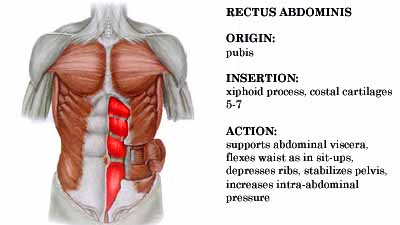 Rectus Abdominis |
Origin: Pubic crest and symphysis
Insertion: Xiphoid process and inferior ribs (5-7) Action: Flexes lumbar spine; compresses abdomen; unilaterally flexes trunk ipsilaterally |
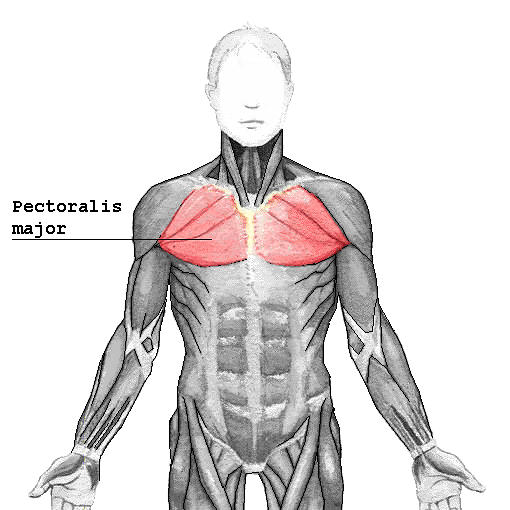 Pectoralis Major |
Origin: Medial half of anterior surface of clavicle, anterior surface of costal cartilages of ribs 1-6 and adjaccent sternum
Insertion: Greater tubercle of the humerus and intertubercular crest (lateral aspect of intertubercular groove) Action: Adducts in frontal plane, flexes in sagittal plane, horizontally adducts in transverse plane, and internally rotates arm |
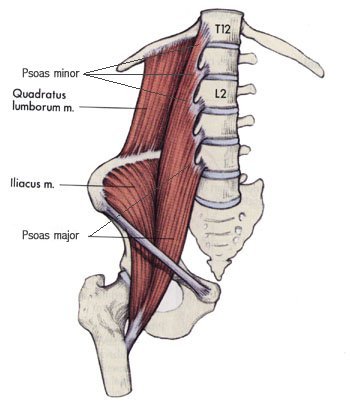 Iliopsoas |
Origin: Iliacus - inner surface of ilium. Psoas major & minor - on intervertebral cartilages, along bodies and lower borders of transverse processes of L1-5; body of T12, on sacrum lateral and inferior to L5-S1 articulation
Insertion: Iliacus & psoas major - lesser trochanter of femur and shaft immediately inferior. Psoas minor - Pectineal line and iliopectineal eminence of ilium Action: Flexion of the hip; flexion and external rotation of the femur |
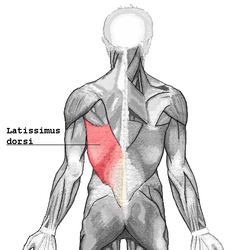 Latissimus dorsi |
Origin: Posterior crest of ilium; spinous processes of T7-S3, ribs 10-12
Insertion: Medial side of intertubercular groove of humerus Action: Adducts in frontal plane, extends in sagittal plane, horizontally abducts in transverse plane, and internally (medially) rotates arm |
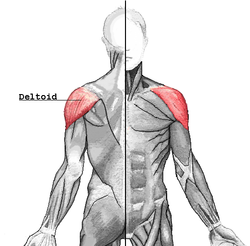 Deltoid |
Origin: 3 portions - anterior lateral 1/3 of clavicle, lateral aspect of acromion process, and inferior edge scapular spine
Insertion: Deltoid tuberosity of humerus (lateral) Action: (1) Abducts arm, assists in flexion, horizontal abduction, and internal rotation of glenohumeral joint (GHJ); (2) abduction of GHJ; (3) abduction, extension, horizontal abduction, and lateral rotation of GHJ |
 Biceps brachii |
Origin: Long head - superior margin of glenoid fossa. Short head - coracoid process of scapula
Insertion: Radial (bicipital) tuberosity of radius and bicipital aponeurosis Action: Flexes elbow, weakly flexes glenohumeral joint; supinates hand |
 Triceps brachii |
Origin: Infraglenoid tubercle of scapula (1), lateral (2) and posterior (3) surfaces of the humerus
Insertion: Olecranon process of ulna Action: Extends elbow (1-3); adducts and extends glenohumeral joint (1) |
 Extensor digitorum |
Origin: Lateral epicondyle of humerus
Insertion: 4 tendons to the dorsal surfaces of the base of middle and distal phalanges of fingers 2-5 Action: Extends digits 2-5 at metacarpophalangeal (MCP) joints and wrist; weak extension o |
 Flexor digitorum superficialis |
Origin: Medial epicondyle of humerus; medial coronoid process of ulna; upper 2/3 of anterior border of radius
Insertion: 4 tendons that divide and attach to the sides of medial phalanges of fingers 2-5 Action: Stabilizes trunk in hip extension; extension and external rotation of hip; lower fibers assist in hip adduction |
 Gluteus maximus |
Origin: Posterior 1/4 of iliac crest; posterior surface of sacrum and coccyx near ilium; and lumbar fascia
Insertion: Oblique ridge on lateral surface of great trochanter and iliotibial band of fasci latae Action: Extension of the knee and flexion of the hip |
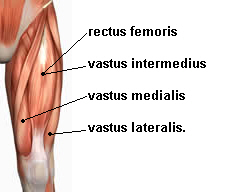 Rectus femoris |
Origin: Anterior surface of superior iliac spine and superior & posterior margin of acetabulum
Insertion: Superior aspect of patella and patellar tendon to the tibial tuberosity Action: Extension of the knee and flexion of the hip |
 Biceps femoris |
Origin: Long head - ischial tuberosity. Short head - lower half of linea aspera and lateral condylar ridge of femur
Insertion: Lateral condyle of tibia and head of fibular Action: Flexion of knee, extension of hip, external rotation of hip and knee |
 Gastrocnemius |
Origin: Medial head - posterior surface of the medial femoral condyle. Lateral head - posterior surface of lateral femoral
Insertion: Posterior surface of calcaneus via calcaneal (Achilles') tendon Action: Plantar flexion of ankle; weak flexion of the knee |



